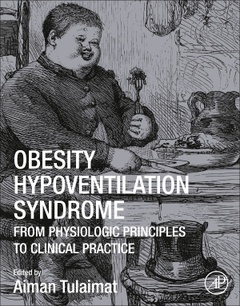Description
Obesity Hypoventilation Syndrome
From Physiologic Principles to Clinical Practice
Coordinator: Tulaimat Aiman
Language: English
Subject for Obesity Hypoventilation Syndrome:
Keywords
Acetazolamide; Acute respiratory failure; Anesthesia; Apnea; Arousal threshold; Asynchrony; Autonomic nervous system dysfunction; Bariatric surgery; Behavior modification; Bicarbonate; Bicarbonate levels; Bilevel positive airway pressure; Bilevel therapy; BIPAP; Breathing pattern; Carbon dioxide; Cardiovascular disease; Central apnea; Cheyne-Stokes respiration; Clinical assessment; Compliance; Continuous positive airway pressure; COPD; CPAP; Critical closing pressure; Duodenal switch; Dyspnea; Fat distribution; Furosemide; Health disparities; History; Home sleep apnea testing; HSAT; Hypercapnia; Hypercapnic respiratory failure; Hypersomnia; Hypopnea; Hypoventilation; Hypoxemia; Inflammation; Leptin; Lifestyle interventions; Loop gain; Lung volumes; Metabolic control of breathing; Metabolic syndrome; Monitoring; Morbidity; Mortality; Neurocognitive impairment; NIV; Noninvasive ventilation; Noninvasive ventilation (NIV); Obesity; Obesity hypoventilation syndrome; Obstructive sleep apnea; OHS; Papilledema; Pendrin; Perioperative; Pharmacotherapy; Phenotyping; Physiology of normal breathing; Polycythemia; Polysomnography; Positive airway pressure; Prevalence; Progesterone; PSG; Pulmonary gas exchange; Pulmonary hypertension; Pulmonary physiology; Pulse oximetry; Quality of life; Resistance; Respiratory acidosis; Respiratory centers; Respiratory failure; Respiratory mechanics; Risk factors; Roux-en-Y gastric bypass; Sleep-disordered breathing; Sleepiness; Sleeve gastrectomy; Social determinants of health; Software; Spirometry; Surgery; Surgical weight loss; Symptoms; Technology; Tracheostomy; Tracheostomy complications; Tracheostomy for obesity hypoventilation syndrome; Tracheostomy for obstructive sleep apnea; Tracheostomy tube selection; Upper airway muscle responsiveness; Upper airway surgery; VAPS; Ventilatory response; Volume-assured pressure support; Weight loss; Weight loss diets; Work of breathing
298 p. · 21.4x27.6 cm · Paperback
Description
/li>Contents
/li>Readership
/li>Biography
/li>Comment
/li>
Obesity Hypoventilation Syndrome: From Physiologic Principles to Clinical Practice summarizes the current state of knowledge regarding the epidemiology, physiology and treatment of obesity hypoventilation syndrome (OHS). Currently, the identification and management of OHS is suboptimal, especially in the acute setting, hence the misdiagnosis or mislabeling of the problem has a significant impact on patient outcomes. This volume brings together all aspects of assessment and management into a main resource for understanding the complex physiological and clinical consequences of this condition.
I. Historical and social introduction 1. Obesity: A social and public policy perspective 2. History of obesity hypoventilation
II. The burden of obesity on respiratory health 3. Effect of obesity on the respiratory system 4. The burden of obesity hypoventilation syndrome
III. Pathophysiology of obesity hypoventilation syndrome 5. Neural control of breathing in sleep 6. Pathogenesis of sleep apnea 7. The pathophysiology of obesity hypoventilation syndrome 8. Evolution of obesity hypoventilation syndrome 9. Cardiovascular, neurological, and inflammatory complications of obesity hypoventilation syndrome
IV. Clinical assessment of a patient with obesity hypoventilation 10. Assessment of patients with obesity hypoventilation syndrome 11. Detection of hypoventilation 12. Diagnosis of sleep-disordered breathing
V. Management of obesity hypoventilation 13. Positive airway pressure I: Equipment 14. Positive airway pressure II: Settings and outcomes 15. The effects of weight loss, tracheostomy, and medication on obesity hypoventilation syndrome 16. Weight loss: Lifestyle interventions and pharmacotherapy 17. Surgical weight loss 18. Tracheostomy in morbidly obese patients 19. Obesity hypoventilation in the intensive care unit 20. Perioperative considerations and management in patients with obesity hypoventilation syndrome
Research scientists as well as respiratory and sleep medicine specialists.
He has over 20 articles, 3 book chapters, 3 letters and 34 abstracts published in the field of respiratory medicine/pulmonary.
- Provides one page chapter summaries that cover epidemiology, physiology and treatment options
- Presents an easy to use reference on obesity hypoventilation syndrome, including symptoms
- Contains chapters with detailed discussions of topics, including color images, graphs and tables that summarize current research

